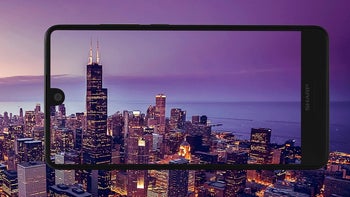Sharp's new European smartphone lineup is in bad need of a flagship

While our Western readers may not be very familiar with Sharp’s smartphone designs, the Japan-based TV and display specialist is actually the leader of its home market when it comes to Android devices.
A key iPhone panel supplier for many years now, the company was acquired by Foxconn back in 2016, and the world’s largest contract electronics manufacturer wasted no time modernizing and expanding its subsidiary’s production facilities.
But Sharp also wants a piece of the global smartphone pie for itself, returning to Europe with a fresh trio of own-brand Android handsets. Unfortunately, these aren’t as ambitious as some of the company’s Japan or China-first “full-screen” flagships, although they do claim to offer “almost bezel-less FreeForm” designs.
The Sharp Aquos D10 comes closest to the borderless dream, at least on paper, purportedly sporting a 91 percent screen-to-body ratio. For some reason, the high-end (ish) 6-incher is the only one of the three phones unveiled today that doesn’t have its specs and features detailed on Sharp’s official European website.
We also don’t have a lot of official Aquos D10 images, but those we’ve managed to dig up confirm the handset features both a fairly wide notch and a large enough chin to accommodate a company logo.
The 2,160 x 1,080 (Full HD+) display is equipped with top-notch Aquos technology and something called WCGP (Wider Color Gamut Panel), while your imaging needs are adequately fulfilled by a dual 12 + 13MP rear-facing camera setup and single 16MP selfie shooter.
Interestingly enough, the lower-end Sharp Aquos C10 and non-Aquos B10 are priced the same, at €299, despite being two very different products. The former claims an 87.5 percent screen-to-body ratio with a huge bottom bezel and Essential Phone-style screen cutout at the top, whereas the latter settles for “traditionally” thick borders.
The Sharp B10 comes with an unremarkable 5.7-inch 1440 x 720 display and outright terrible Android 7.0 Nougat software, as well as a MediaTek MT6750T SoC, 3GB RAM, and 32GB storage.
In contrast, the 5.5-inch Sharp Aquos C10 boasts 2040 x 1080 screen resolution, Android 8.0 Oreo, Snapdragon 630 processing power, 4 gigs of memory, and 64 of local digital hoarding room. The C10 also combines 12 and 8MP rear-facing camera sensors with f/1.75 and f/2.0 aperture respectively, while the B10 has a primary 13MP f/2.0 shooter and secondary 8MP wide angle lens.
But the larger, overall humbler device comes with a hefty 4,000 mAh battery, compared to a skinny 2,700 mAh cell under the Aquos C10’s hood.
To recap, the prices are right, the specs... mixed, and the designs nothing to write home about. Any interest in Sharp’s “big” (and still vague) European comeback?
A key iPhone panel supplier for many years now, the company was acquired by Foxconn back in 2016, and the world’s largest contract electronics manufacturer wasted no time modernizing and expanding its subsidiary’s production facilities.
The Sharp Aquos D10 comes closest to the borderless dream, at least on paper, purportedly sporting a 91 percent screen-to-body ratio. For some reason, the high-end (ish) 6-incher is the only one of the three phones unveiled today that doesn’t have its specs and features detailed on Sharp’s official European website.
We also don’t have a lot of official Aquos D10 images, but those we’ve managed to dig up confirm the handset features both a fairly wide notch and a large enough chin to accommodate a company logo.
Reportedly priced at €399 on the old continent, the D10 packs a modest (by flagship standards) Snapdragon 630 processor, meek (by any standards) 2,900 mAh battery, as well as a respectable 64GB internal storage space and 4GB RAM.
The 2,160 x 1,080 (Full HD+) display is equipped with top-notch Aquos technology and something called WCGP (Wider Color Gamut Panel), while your imaging needs are adequately fulfilled by a dual 12 + 13MP rear-facing camera setup and single 16MP selfie shooter.
Interestingly enough, the lower-end Sharp Aquos C10 and non-Aquos B10 are priced the same, at €299, despite being two very different products. The former claims an 87.5 percent screen-to-body ratio with a huge bottom bezel and Essential Phone-style screen cutout at the top, whereas the latter settles for “traditionally” thick borders.
In contrast, the 5.5-inch Sharp Aquos C10 boasts 2040 x 1080 screen resolution, Android 8.0 Oreo, Snapdragon 630 processing power, 4 gigs of memory, and 64 of local digital hoarding room. The C10 also combines 12 and 8MP rear-facing camera sensors with f/1.75 and f/2.0 aperture respectively, while the B10 has a primary 13MP f/2.0 shooter and secondary 8MP wide angle lens.
But the larger, overall humbler device comes with a hefty 4,000 mAh battery, compared to a skinny 2,700 mAh cell under the Aquos C10’s hood.
To recap, the prices are right, the specs... mixed, and the designs nothing to write home about. Any interest in Sharp’s “big” (and still vague) European comeback?













Things that are NOT allowed: